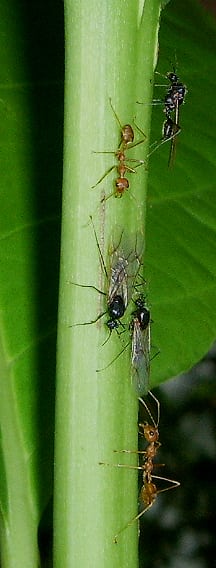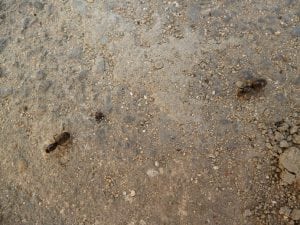A long-standing myth about epilepsy is that it is tied to the lunar cycle, worsening during the full moon. Just Google it to see what comes up in the search… But the boundary between what we see as myth and what eighteenth-century people saw as medicine is blurry, as a quick search of the Sloane Correspondence database for epilepsy shows.

A man suffering from mental illness or epilepsy is held up in front of an altar on which is a reliquary with the face of Christ, several crippled men are also at the altar in the hope of a miracle cure. Credit: Wellcome Library, London.
In February 1739, physician Christopher Packe consulted with Sir Hans Sloane about Mr Roberts’ recent epileptic fit (BL Sl. MS 4076, f. 220). Before describing the fit, Packe specified that it occurred on the morning of the full moon. Before the fit, the patient appeared wild and suffered from a numb leg and a swollen nose. In the hopes of preventing a seizure, Packe prescribed a vomit. Mr Roberts, moreover, had been diligent in following Sloane’s orders: a restricted diet and various medicines. Everything was being done that could be done, to no avail, and Packe was “apprehensive” of the next full moon.
An undated, unsigned letter came from a gentleman aged 28, who had been “seized with epilepsy two months ago” after having no fits between the ages of 16 to 20 (BL Sl. MS 4078, f. 329). Epilepsy ran in his family, he reported, with his mother being “subject to it or at least violent hysterick disorders from girlhood” and his father having seizures for several years before death. The patient wondered if the trigger had been his change from winter clothes to spring clothes, as well as drinking more than usual for several weeks prior to the recurrence. The timing of his changed lifestyle could not have been worse, since “about three days before the full moon immediately preceeding the Vernal equinox he fell into that fitt”.
The focus of these letters on full moons and clothing changes may seem superstitious to us today—and the parallel between epilepsy and hysteria perplexing—but reflected the wider medical understanding of the time. Botanist Joseph Pitton de Tournefort (with whom Sloane studied in France) and physician Thomas Sydenham (with whom Sloane worked in England) considered hysteria and epilepsy to be related: convulsive disorders that affected the brain.[1] According to contemporary treatises, other related ailments included vertigo, palsy, melancholy, fainting, and rabies.[2]
Well-known physicians Thomas Willis (1621-1675), Richard Mead (1673-1754) and John Andree (1699-1785) discussed some of the old stories about epilepsy. Willis and Andree noted that epileptic fits were so shocking to observers that they had, in previous times, been attributed to demons, gods or witchcraft.[3] Willis’s remedies may appear just as magical to modern eyes, but they would have been common in early modern medicine. There was also a key difference: he treated epilepsy as natural rather than supernatural. Willis began his treatments with a careful regime of vomits, purges, and blood-letting to prepare the body for preventative remedies. These included concoctions of male peony, mistletoe, rue, castor, elk claws, human skull, frog liver, wolf liver, amber, coral (and so much more), which would help in tightening the pores of the brain. Some of the medicines were also to be worn on the body rather than ingested, perhaps a silk bag (elk hoof, mistletoe and peony roots) at the waist or an elder stalk amulet at the neck.[4]
By the time Andree was writing, some of Willis’ seemingly magical recommendations had been lost, although most of the remedies remained the same. Andree, however, looked beyond the brain for the source of the problem. He emphasised that it was important to identify the underlying cause of the epilepsy: humoral obstruction, plethora of blood, head injury, worms or fever.[5]

The moon, viewed in full sunlight. Stipple engraving, 1805. Credit: Wellcome Library, London.
The moon continued to be important in Mead’s and Andree’s understanding of epilepsy. Mead argued that the human body was intimately affected by the influence of the sun and moon, with epilepsy and hysteria being particularly subject to lunar periods. The most critical of these were the new or full moons around the vernal and autumnal equinox, moments of important change. Mead was particularly interested in periodicity within the human body, which included periodical hemorrhages (including menstruation). Using the same rationale for explaining men’s periodical hemorrhages, Mead seemed to suggest that weak or plethoric (too much blood) bodies were particularly subject to the lunar cycle.[6]
Andree took the effects of the moon on epilepsy as a given, recommending that epileptic patients be given vomits around that time. He focused on the necessity of regulating the body through good management to prevent weakness and plethora. Drunkenness and gluttony, erratic emotions or sudden frights, overuse of opiates, excessive sexual intercourse could all trigger epilepsy. Puberty, with its rapid changes to the body, was a dangerous time when epilepsy might go away altogether, or worsen. Epilepsy that did not go away was thought to result in gradual degeneration—stupidity, melancholy, palsy, cachexia (weakness)—that would be difficult to treat.[7]
No wonder Sloane’s patients were so worried! For Dr Packe, Mr Roberts’ condition would have appeared to be deteriorating, in spite of the best efforts of doctor and patient. And the unnamed gentleman, given his family’s medical history, must have blamed himself for making potentially disastrous choices at one of the worst times of year. Timing was everything when it came to epilepsy. In Sloane’s lifetime, many old ideas about epilepsy had been relegated into the realm of myth, but a connection between the full moon and epilepsy remained as firm as ever.
[1] Joseph Pitton de Tournefort, Materia medica; or, a description of simple medicines generally used in physick (1716), pp. 84, 265; Thomas Sydenham, Dr. Sydenham’s compleat method of curing almost all diseases, and description of their symptoms (1724), p. 150.
[2] See, for examples, Richard Mead, Of the power and influence of the sun and moon on humane bodies (1712); John Andree, Cases of the epilepsy, Hysteric Fits, and St. Vitus Dance, & the process of cure (1746); Thomas Willis, An essay of the pathology of the brain and nervous stock in which convulsive diseases are treated of, 2nd edition (1684).
[3] Willis, p. 11; Andree, p. 7.
[4] Willis, pp. 18-20.
[5] Andree, pp. 3, 10-12.
[6] Mead, pp. 31-42.
[7] Andree, pp. 10-12, 25.

![We can see here that Lister's daughters Susanna and Anna were credited with doing the illustrations: "Susanna et Anna Lister pinx[erunt]".](http://sloaneletters.com/wp-content/uploads/2013/08/1868191187a0f457ea93d0e0ba5a.jpg)















